Japanese atomic bomb survivors are striving for every possible way to convey the harrowing experiences they had in Hiroshima and Nagasaki, knowing that time is running out for them to use their own words.
Art is one of the methods they rely on. And they believe messages about what happened in the cities nearly eight decades ago will be carried through even the hands of young artists in the making who were born long after the war was over.
Last fall, a group of A-bomb survivors in Fukuoka reached out to Kyushu Sangyo University and asked that art-course students there create painting works to be used when they speak to school children about the devastation caused by the attacks.

The university in the southwestern city responded positively to the request from the hibakusha, as the bombing survivors are known, and three female students stepped forward to volunteer.
One of them, Nanaka Ikeda, 20, completed a picture based on a description by Isamu Hiraki, 85, who witnessed the explosion of the atomic bomb roughly 4 kilometers from its hypocenter in Nagasaki.
Ikeda initially showed Hiraki four rough sketches incorporating the A-bomb and B-29 bomber that delivered it, but none of them satisfied him.

With Hiraki describing the explosion as "looking exactly like the sun," Ikeda redid the painting, using a technique to make it appear three-dimensional while showing a powerful burst of bluish-white light over the entire canvas.
Ikeda was born in Kitakyushu in Fukuoka Prefecture, an industrial city which had a weapons factory for the Japanese Imperial Army and was the initial target of the second U.S. atomic bombing on Aug. 9, 1945.
When she was a child, her grandmother told her about her great-grandfather who died in the war. "I will continue to learn about the war and pass it down to future generations," she said.
Wakana Miyasako, 21, depicted the horror experienced by Hiroko Nakagawa, 82, who was exposed to radiation at her home about 1.2 km from the hypocenter in Hiroshima three days earlier than the Nagasaki bombing.

Nakagawa fled raging fires with her mother, grandmother and 11-month-old sister. When they tried to cross a river in a wooden raft after a nearby bridge collapsed, the mother fell into the river with her baby in her arms.
From the river, her mother held the baby up, pleading for someone to grab her. Nakagawa and her grandmother survived, escaping the approaching fires, but her mother and younger sister, who was pulled onto the raft shortly afterward, died.
Miyasako's painting shows an image of a person aboard a raft reaching out to pull the mother and her daughter out of a black river strewn with bodies. The painting captures Nakagawa's desire "to emphasize the tragedy of war and the importance of living life to the fullest."
Miyasako admitted the work was "very difficult" due to her lack of experience in drawing scenes of death.

In a painting by Maika Sugawara, 20, a woman with a forlorn expression interlaces her fingers in prayer as her children stand near her in the background.
It is the moment the mother of Mitsuya Okazaki, 87, shouted, "No more war" two days after the atomic bombing of Nagasaki. That day, Okazaki witnessed a river filled with dead bodies while walking with his mother near the center of the explosion.
The three paintings, completed in about eight months, were displayed at an atomic bomb exhibition held by the hibakusha group in August. With such unimaginable memories as their subject matter, the students resolved to pass on the message of peace.
The university is planning a second round of the project. Yasuhide Kunimoto, lecturer in the art faculty, said, "Now is really the last chance to listen to the experiences of hibakusha. I want to encourage as many students to participate as possible."
Related coverage:
Special feature: How an Atomic Bomb Destroyed a Girl's Life
FOCUS: Memes win U.S. fans for "Oppenheimer" but raise eyebrows in Japan
Japan marks 78th anniv. of WWII end as PM reiterates war opposition
 By Eriko Noguchi,
By Eriko Noguchi,










